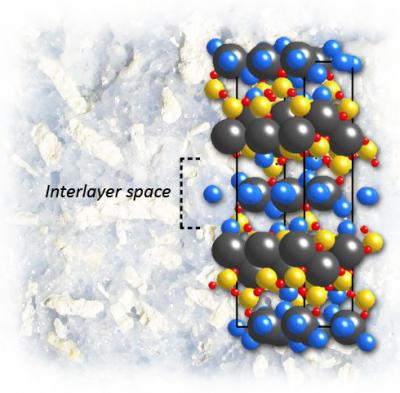Professor of civil and environmental engineering, the University of California at Berkeley, Paulo Monteiro stated that it is important to understand the structure of Portland cement at the nanoscale.
 In nanoscale studies of calcium-silicate-hydrate, a binder critical to the strength and durability of Portland cement, the mineral tobermorite is a perfect stand-in for determining the crystal structure of this extraordinarily complex material. Highly structured layers of calcium and oxygen atoms alternate with "interlayers" of silicon, oxygen, calcium, and water molecules, where disorder may occur and adversely affect the material's properties. (Credit: Crystal structure of 14Å tobermorite as refined by Bonaccorsi et al)
In nanoscale studies of calcium-silicate-hydrate, a binder critical to the strength and durability of Portland cement, the mineral tobermorite is a perfect stand-in for determining the crystal structure of this extraordinarily complex material. Highly structured layers of calcium and oxygen atoms alternate with "interlayers" of silicon, oxygen, calcium, and water molecules, where disorder may occur and adversely affect the material's properties. (Credit: Crystal structure of 14Å tobermorite as refined by Bonaccorsi et al)
For this purpose, Paulo Monteiro in partnership with scientists from the Advanced Light Source (ALS) at Lawrence Berkeley National Laboratory of the U.S. Department of Energy has for the first time carried out a study on bulk modulus or stiffness of tobermorite mineral. At the ALS beamline 12.2.2, the California High-Pressure Science Observatory (Calipso), the research team compressed the tiny sample of the mineral between the faces of a pair of diamonds of a diamond anvil cell by gradually applying pressures equivalent to that of 100 mi. under the earth surface.
The team observed the change in structure of the material with respect to the increase in pressure using diffraction patterns received by passing a bright X-ray beam through the sample. The findings of the study help better understand calcium-silicate-hydrate (C S H), which provides durability and strength to Portland cement concrete. The tobermorite mineral is a calcium silicate hydrate and one of its forms named 14Å tobermorite is an ideal substitute for studying C-S-H at the nanoscale.
For the experiment, the research team pulverized the tiny sample into a fine powder and dispersed it in a liquid in order to allow the diamond anvil cell to apply constant hydrostatic pressure on each grain in the chamber, a hole in a metal gasket having a diameter of just 180 millionths of one meter.
Monteiro stated that tobermorite structure’s lattice parameters can be obtained from the diffraction patterns. The research team was able to calculate the unit cells’ volume in three directions using lattice parameters, he said. The team used the modifications in the lattice parameters corresponding to the changes in pressure as a strain gauge, he added. The bulk modulus of the material can be calculated using the pressure applied in the anvil cell, he said.
C-S-H comprises oxygen, silicon and calcium atoms aligned as a pile of flat layers. Oxygen and calcium atoms’ highly structured layers exchange with interlayers of calcium, oxygen, water and silicon molecules. Tobermorite demonstrates high stiffness along the layers’ plane or the lattice parameters’ a and b directions, while experiencing small change when pressure increases. The material demonstrates high compressibility when at right angle to the plane in the c-axis.
Monteiro stated that interlayers along the c-axis can only be compressed. The two materials demonstrate same bulk modulus in the a-b plane but different in the c-axis due to variations in interlayer spacing and differences in degrees of disorder in the water molecules, extra calcium ions and the silicon chains, he said. These findings are helpful in enhancing the cement performance by introducing novel polymers into the interlayers of C-S-H to refine its behavior, an area of focus of the team’s future research, he said.